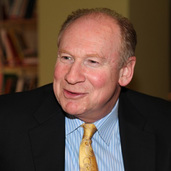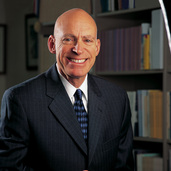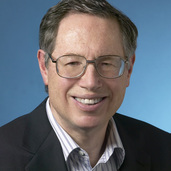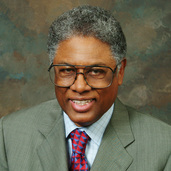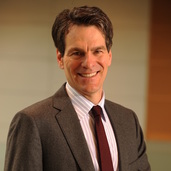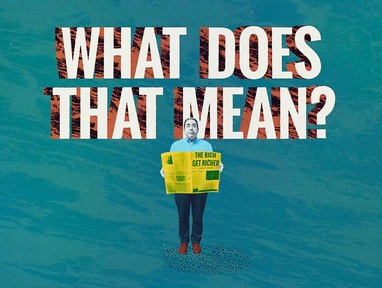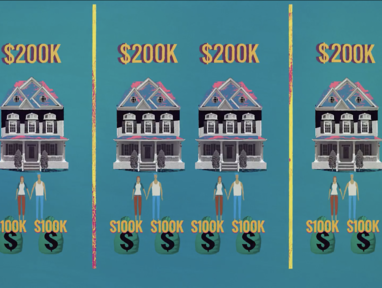Inequality
How Do We Measure Income Inequality?
There are many measures of inequality. The most common methods look at the dispersion of annual income across households. There are simple measures that look at income ratios of high-income to low-income households. There are complicated measurements such as the Gini coefficient; it measures how unequal income is relative to an economy where everyone receives the same amount. These measurements all show widening income inequality in the United States. For example, the US Census Department annual report on income and poverty shows that the Gini coefficient has risen from .40 to .48 over the last 50 years (bigger numbers are indicative of more inequality).
But, while the above statistics are often mentioned, they come with significant caveats.
For starters, there is disagreement over what should count as income. The Census Bureau statistics mentioned above rely on a particular definition of income called “money income.” As Lee Ohanian and Kip Hagopian explain, money income fails to capture many economic resources available to households:
“Money income, which is the definition of income typically used in public references to inequality, consists of cash income only, does not subtract taxes, excludes the value of noncash transfer payments (such as nutritional assistance, Medicare, Medicaid, and public housing), as well as many other components of income. In addition to transfer payments, which are a substantial portion of income at the low end of the income scale, some of the other missing components of income are: employer-provided fringe benefits (primarily retirement benefits and health insurance, which can amount to as much as 30 percent of income), capital gains, imputed rent from owner-occupied housing, and increases in the value of home equity. We believe excluding these items renders this measure of income inequality relatively meaningless.”
Then there is the question of what time period we should use. The most commonly cited inequality measurements look at annual income, but these are subject to large fluctuations. People may report a high income in one year because they received a one-time bonus or they sold assets. They may report a low income in other years because they are in school or have retired. Economist Russ Roberts explains why this matters:
“Almost all the gloomy evidence that people use showing the rich getting all the gains . . . take a snapshot each year and compare the snapshot today with one from the past to see how people have been doing. But it’s not the same people in the snapshots. The economy’s dynamic. People move up and down. They have good years. And bad ones. People leave school and start working. People retire. Some die.”
Watch this video to learn more about this phenomenon:
The population being measured matters as well. Some measures of inequality compare every adult in one time period to every adult in another time period. But there are many more retired people now than there were several decades ago. That means more of the population isn’t earning money, which contributes to inequality. A more accurate representation would be to compare working-age adults over a time period.
Deciding what should count as income and accounting for natural fluctuations in income make it hard to say whether the income gap is widening. We need to find a better measurement of inequality.
Are There Better Measurements Of Inequality?
Rather than try to measure inequality with annual income, we could look at consumption. Consumption data provide a more complete view of economic well-being. Unlike most income definitions, consumption accounts for the effects of taxes, noncash benefits such as food stamps, and employer-provided fringe benefits. In addition, relative to annual income or wealthy, consumption isn’t prone to large fluctuations. College students with little to no income are able to consume by taking out student loans. During their careers, they pay off those student loans as they consume less than they earn and, eventually, save for retirement. Then when they retire, they draw down those savings, once again, consuming more than their incomes.
Income and wealth equality also fail to show who is actually using society’s resources. As Richard Epstein explains: “Rather than just engaging in massive consumption, the rich, especially at the billionaire level, typically reinvest or give a large fraction of their wealth, often to charitable enterprises. The upshot is that the distribution in consumption is far more equal than that in income.”
Sure enough, when we look at consumption inequality, we find that inequality hasn’t grown nearly as much as income inequality statistics suggest. Some studies find no increase in consumption inequality, while others find it has grown slightly. Ohanian and Hagopian summarize the research here, concluding that “consumption inequality is considerably lower than income inequality.”
Is Inequality The Best Metric For The Health Of Our Economy?
Rather than focusing on relative differences in income or consumption, we should ask whether families and individuals are doing better over time. Are their incomes growing? Do they have economic opportunities?
These questions deal with economic mobility, and they get to the heart of the matter of whether our economic system is working.
In the video series America’s Exceptional Economy, economist Ed Lazear takes a look at how well the American economy is doing. He offers a positive report. Whether one looks at income growth, economic mobility, or job opportunities, the American economy receives high marks, especially relative to other advanced economies. Watch the first video of the series here to learn more:
Lazear reports that economic mobility across generations is strong:
“Ninety-three percent of children in the lowest quintile—that is, the people whose parents were in the bottom 20 percent—do better than their parents. That’s not so surprising. If you start out at the bottom, it’s easier to rise to the top. But even among the top 20 percent, 70 percent of children do better than their parents. That’s pretty good.”
And even if we just look at income distribution, we find that Americans move up and down the scale: “Of the people who are currently in the top 20 percent of earners in the United States, 60 percent came from families that were in quintiles other than the top 20 percent.”
How Is The Middle Class Actually Doing?
Lazear’s findings sure seem to contradict the prevailing wisdom reported and repeated frequently in the media that middle-class incomes have stagnated over the last 30 years. The popular argument goes that wages have not risen any faster than prices, so today’s middle class is no better off than prior generations. Is this true?
In The Numbers Game series, economist Russ Roberts highlights how common economic statistics fail to capture gains achieved by the middle class. Roberts explains how the composition of American households is changing in ways that distort income statistics. For example, statistics showing stagnant middle-class incomes are partially just a result of demographics. As more and more baby boomers retire, average wages and salaries among middle-class Americans have fallen. Watch this video to learn more:
In another video, Roberts looks at how official inflation statistics overstate how much prices have risen because they fail to fully capture the value of quality improvements and new technology.
Is There Any Reason To Be Concerned About Inequality?
Even if inequality is rising, it doesn’t mean that our economy or public policies are broken. It’s the source of inequality that matters.
We should be very concerned if growing inequality is the consequence of theft, exploitation, or special government privileges—what economists call rent seeking. Rent seeking doesn’t improve society. At best, it merely transfers resources from one group to another. In many cases, it makes society poorer. Economist David Henderson offers the example of billionaire Carlos Slim: “The Mexican government handed him a monopoly on telecommunications in Mexico and he uses it to charge high prices for phone calls. Slim is clearly exacerbating income inequality in a way that makes other people poorer.”
In contrast, we should be less concerned if inequality is caused by growing incomes for innovators and entrepreneurs. We all benefit in an economy where inventors are rewarded for creating new technologies, scientists for curing diseases, or businesses for producing cheaper, higher-quality goods. Most people understand this idea—that is why few people are concerned about the wealth of Bill Gates or the late Steve Jobs. Here is Henderson again, explaining how this benefits society:
“In any given year, there isn’t just one inventor or innovator. There are thousands. So each one’s success increases wealth inequality a little but also improves the well-being of tens of millions of people who are less wealthy. Also, as other competitors enter the market and compete with the innovator, they drive down prices and make consumers even better off. Indeed, Yale University economist William D. Nordhaus has estimated that only 2.2 percent of the gains from innovation are captured by the innovators. Most of the rest goes to consumers.”
What Are The Costs Of Addressing Inequality?
Even if the sources of inequality are innocuous or even beneficial to society, we might still be concerned that concentration of wealth or income could lead to bad outcomes. Economist John Cochrane summarizes one of the main concerns expressed by people who worry about growing inequality:
“They worry that too much money is corrupting politics, and they want to take away the money to purify the politics. That explains the obsessive focus on the income and wealth of the top 1 percent. Consumption may be flatter, but income and wealth buy political connections. And all of our concern about the status of the poor, the returns to skill, awful education, the effects of widespread incarceration, all this is irrelevant to the money-and-politics nexus.”
These concerns may justify doing something about inequality, but the question is whether the proposed measures to address inequality will do more harm than good.
The most commonly suggested solution to growing inequality is much higher tax rates on the wealthy. These could include higher marginal income taxes or new taxes on wealth. The hope is that higher taxes will lower the incomes of rent seekers and reduce their incentive to lobby government for special privileges. But higher taxes are, at best, a blunt method for doing so. In fact, raising taxes and giving more power to the government would seem to invite more rent seeking. As John Cochrane asks, “If the central problem is rent-seeking—abuse of the power of the state—to deliver economic goods to the wealthy and politically powerful, how in the world is more government the answer?”
So, raising taxes is unlikely to reduce the problem of rent seeking. Higher taxes will, however, reduce economic incentives that lead to new technologies, cures for diseases, and better goods and services. As explained in this video, high rates slow economic growth and reduce opportunities for all Americans by undermining a taxpayer’s decision to work and invest:
We all benefit by the success of entrepreneurs and innovators. Trying to reduce inequality through higher taxes will reduce their incentives to create and invest. A stagnant economy and fewer innovations would follow.
Conclusion
As we have seen, the US economic picture across all income levels is much more encouraging than we thought. Measured correctly, inequality hasn’t grown by nearly as much as we have been told, economic mobility remains strong, and middle-class incomes are rising much faster than official government statistics suggest.
Nevertheless, that doesn’t mean we shouldn’t pursue policies that further increase economic opportunities for all Americans. We can enhance prosperity by supporting policies that grow the economy. This video explains how runaway government spending, high tax rates, burdensome government regulations, and trade barriers hurt growth prospects and diminish prosperity for everyone. Fixing how we spend, tax, and regulate would increase economic opportunity.
Beyond growing the economy, Lee Ohanian argues that we can also improve economic prospects for low-income Americans by fixing our education and immigration policies:
“The lowest earners need more human capital to increase their skills and productivity, and a healthier economy with more job creation. Reforming K–12 education policies through competition and expanding new business creation by allowing immigrant entrepreneurs to remain in the US, will help our lowest earners succeed.”
There are plenty of other economic policies that could improve outcomes for the poor. We talk about some of them in our Policy Insight piece on social safety nets.
We won’t improve economic prospects for lower earners by fixating on perceived inequality at the expense of economic well-being. Arguments about inequality often assume that the economy is a zero-sum game; if there are winners, there must be losers. But that is not how our economy works. We all benefit from better goods and lower prices offered by innovators and entrepreneurs, who often become very wealthy as a result. Undermining their incentives to create and invest may very well reduce inequality, but it will come at the expense of economic opportunity—a prospect that will leave us poorer in the end.
Sources And Additional Reading
In video series The Numbers Game, economist Russ Roberts shows how the US middle class is doing far better than basic economic statistics might suggest. The four-part series reveals that income measurements, demographic changes, and inflation metrics obscure the large economic gains going to the middle class.
Roberts summarizes the research on inequality and mobility from his series in this Medium post.
In this 2017 piece, Richard Epstein explains how inequality statistics omit important aspects of well-being that are distributed far more equality. Epstein points to personal happiness, families, and health as non-pecuniary sources of well-being that we should include when thinking about inequality.
Thomas Sowell discusses common myths about inequality in this 2018 Uncommon Knowledge interview.









